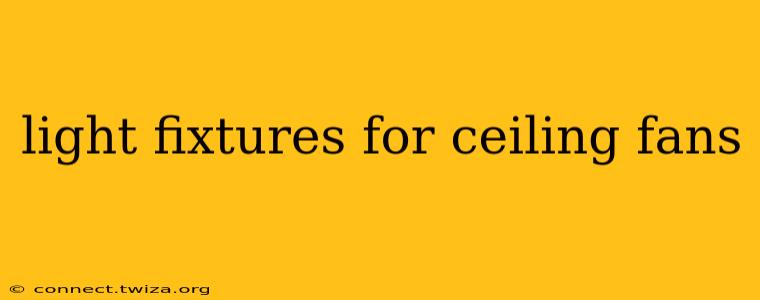Choosing the right light fixture for your ceiling fan can significantly impact your room's ambiance and functionality. It's more than just illumination; it's about finding the perfect blend of style, efficiency, and practicality. This guide will delve into everything you need to know to make an informed decision, answering common questions and providing expert advice.
What are the different types of light fixtures for ceiling fans?
Ceiling fan light kits offer a variety of styles to complement any décor. You'll find options ranging from sleek and modern to traditional and ornate. Popular choices include:
- Bowl lights: These classic fixtures offer diffused, even lighting, ideal for general illumination.
- Flush mount lights: Perfect for rooms with low ceilings, flush mounts sit close to the ceiling, maximizing headroom.
- Pendant lights: These hanging lights add a touch of elegance and can be particularly effective in larger rooms or high-ceiling spaces. They often offer more focused light than bowl fixtures.
- Semi-flush mount lights: A happy medium between flush mounts and pendants, semi-flush mounts offer a bit more style and height while still being suitable for rooms with moderate ceiling heights.
The choice depends largely on personal preference and the architectural style of your home.
How do I choose the right size light fixture for my ceiling fan?
The size of your light fixture should be proportionate to the size of your room and ceiling fan. A tiny light on a large fan will look out of place, and vice versa. Consider these factors:
- Room size: Larger rooms generally accommodate larger light fixtures.
- Ceiling height: In rooms with lower ceilings, smaller, more compact fixtures are preferable to avoid a cluttered look.
- Fan size: The diameter of your ceiling fan should influence your light fixture choice; the fixture shouldn't overpower or be dwarfed by the fan. A good rule of thumb is to select a light kit that is proportionally sized to your fan's blades.
Consult the manufacturer's specifications for your ceiling fan to ensure compatibility with different light kit sizes.
What types of bulbs are compatible with ceiling fan light kits?
Most ceiling fan light kits accommodate various bulb types, but understanding compatibility is crucial for efficiency and longevity. Common bulb types include:
- Incandescent: These produce warm light but are less energy-efficient than other options.
- Halogen: Brighter and more energy-efficient than incandescent bulbs, but still less so than LEDs or CFLs.
- CFL (Compact Fluorescent Lamps): Energy-efficient and long-lasting, but they can take a moment to reach full brightness.
- LED (Light Emitting Diodes): The most energy-efficient option, offering long life and instant brightness. They also come in a wide range of color temperatures.
Always check the manufacturer's specifications for your ceiling fan and light kit to determine the maximum wattage and bulb type it supports. Exceeding the recommended wattage can cause damage.
Can I install a light kit on any ceiling fan?
Not all ceiling fans are designed to accommodate light kits. Some are specifically sold without lighting capabilities. Always check the fan's model specifications to see if it is compatible with a light kit. If your fan doesn't have a light kit option, it might not be possible to add one without significant modifications – best to consult a qualified electrician.
How do I install a light kit on my ceiling fan?
Installing a ceiling fan light kit varies slightly depending on the model. However, generally, it involves:
- Turning off the power: This is crucial for safety.
- Disconnecting the fan: Carefully detach the fan blades and other components to access the mounting bracket.
- Attaching the light kit: Follow the manufacturer's instructions precisely. This typically involves wiring the light kit to the fan's electrical components.
- Mounting the shade: Securely attach the light fixture shade or globe.
- Reconnecting the fan: Reattach the fan blades and other components.
- Testing the lights: Ensure the light kit is functioning correctly before fully reinstalling the fan.
If you're uncomfortable with electrical work, it's best to hire a qualified electrician.
What are the benefits of having a light fixture on my ceiling fan?
Integrating a light fixture into your ceiling fan offers numerous benefits:
- Combined functionality: You get both efficient cooling and convenient illumination from a single unit, saving space and simplifying installation.
- Energy efficiency (with energy-efficient bulbs): Using energy-efficient bulbs minimizes electricity consumption.
- Improved ambiance: The right light fixture can drastically enhance the atmosphere of a room.
- Cost savings: The combined unit often costs less than buying a separate ceiling fan and light fixture.
This comprehensive guide should equip you to choose and install the perfect light fixture for your ceiling fan, transforming your space with both style and functionality. Remember to always prioritize safety and, if unsure about any aspect of installation, consult a professional electrician.
